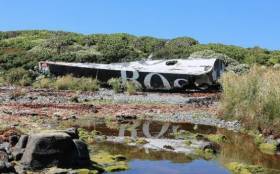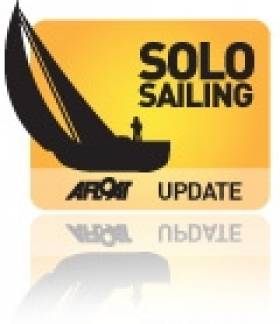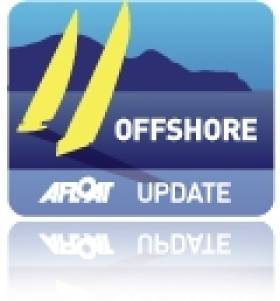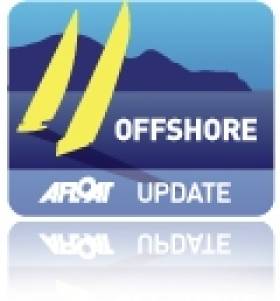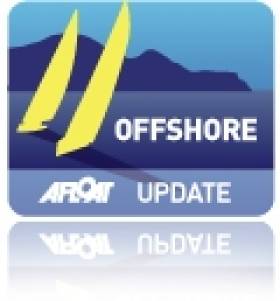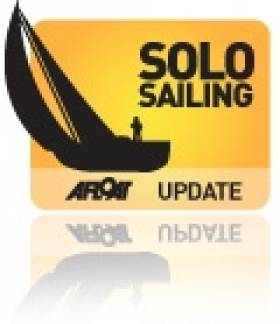Displaying items by tag: Velux 5 Oceans
Kayaker Finds Hugo Boss Yacht Abandoned 10 Years Ago
#AlexThomson - A remains of a yacht abandoned by sailing superstar Alex Thomson a decade ago have been discovered on a remote stretch of South American coastline.
According to Yachting & Boating World, the Hugo Boss skipper was forced to abandon the IMOCA 60 after a broken keel caused a capsize just five weeks into the first leg of the 2006-2007 Velux 5 Oceans offshore race.
But a decade on, Rolex Enterprise Award winner Cristian Donoso was kayaking in the Patagonia region of southern Chile recently when he found what remains of the Hugo Boss hull, located for the first time after it was set adrift in the Southern Ocean.
It's thought that the yacht travelled around 20,000km from the spot off South Africa where Thomson and crew were rescued by fellow Velux racer Mike Golding – moving east across the Indian and Pacific Oceans – to the shoreline at Bernardo O’Higgins National Park, north-west of South America's most southern city Punta Arenas.
Thomson, a regular visitor to Ireland whose replacement Hugo Boss Open 60 stopped off at Cork Harbour in April 2014, is now making arrangements for the boat's retrieval. YBW has more on the story HERE.
The American skipper Brad Van Liew has won the Ocean Sprint Three from Wellington, New Zealand to Punta del Este in Uruguay after 23 days at sea.
Brad Van Liew is a self proclaimed adrenaline junkie with a vast array of extreme sports behind him. A lifelong sailor, Brad had set his heart competing in the BOC Challenge, which would in 2005 be renamed the VELUX 5 OCEANS and in 1998 his dream was realised when he competed in the Around Alone finishing third in class two. Brad lives in Charleston, South
Carolina, USA and his new yacht Le Pingouin, which he bought in France last year, has a rich racing pedigree.
The VELUX 5 OCEANS is the oldest single-handed round the world yacht race. Run every 4 years since 1982, the race is the longest and toughest event for any individual in any sport. The race is a series of five high-pressure ocean sprints within a marathon circumnavigation. The 30,000 route takes the sailors from La Rochelle FR to Cape Town SA, then onto Wellington NZ, Punta
del Este Uruguay, Charleston USA and back to La Rochelle FR, for the finish.
Further VELUX 5 OCEANS images HERE
Velux 5 Oceans: Windy Start to Ocean Sprint 3
The Velux 5 Oceans website has posted a video preview ahead of the third ocean sprint stage in the marathon round-the-world yacht race.
The third stage, which kicks off tomorrow, will take the four competing yachts across the Pacific Ocean from Wellington, New Zealand to Punta de Este in Uruguay.
Sail World reports that northerly gales are expected to buffet the boats from the off as they set out on the incredible 6,000-mile route, which will take them to Nemo Point - the most remote spot in the world - and the notorious challenge of Cape Horn.
American Brad Van Liew, skipper of Le Pingouin, is currently in the lead having won the previous two ocean sprints in the 30,000-mile race.
Gutkowski Second in Spring Leg
Polish solo sailor Zbigniew Gutkowski took second place in ocean sprint two of the VELUX 5 OCEANS solo round the world race. The 36-year-old skipper from Gdansk crossed the finish line in Wellington, New Zealand, on his Eco yacht Operon Racing at 6.27am local time (5.27pm UTC).
Gutkowski arrived less than 24 hours behind leg winner Brad Van Liew. The second of five ocean sprints from Cape Town in South Africa to Wellington
took Gutek 31 days, eight hours and 27 minutes to complete. Zbigniew Gutkowski is one of Poland's best known and most experience sailors with a wealth of offshore and inshore racing. Known as 'Gutek' and from Gdansk, he has experience sailing in a wide range of mono and multihulls and has clocked up ore than 100,000 miles in his bid to become the first Polish sailor ever to race solo around the world.
The VELUX 5 OCEANS is the oldest single-handed round the world yacht race. Run every 4 years since 1982, the race is the longest and toughest event for any individual in any sport. The race is a series of five high-pressure ocean sprints within a marathon circumnavigation. The 30,000 route takes the sailors from La Rochelle to Cape Town, then onto Wellington, Salvador, Charleston and back to La Rochelle for the finish.
Velux 5 Oceans Skippers Prepare for Storm
Velux 5 Oceans skippers are battening down the hatches as a summer storm surges towards the fleet in the Southern Ocean - with giants swells and winds of more than 40 knots expected
“I’m a little anxious, I want to make sure I take care of the boat,” said sprint leader Brad Van Liew, American skipper of the Eco 60 'Le Pingoui'.
"If it doesn’t bring too much unexpected weather we could get some good fast sailing from it. If it ends up bringing a lot more wind than forecast it could be a lot more dangerous.”
Van Liew and his fellow racers have already spent three weeks at sea in the second ocean sprint, covering 5,000 nautical miles, with 2,500 left to go to the finish line in Wellington, New Zealand.
At this stage speed is of the essence, but safety is paramount - the Velux 5 Oceans skippers must make sure they they stay in the race if they want to contend for a podium finish.
As of 6pm yesterday, Le Pingouin was in the lead ahead of Zbigniew Gutkowski in Operon Racing, Derek Hatfield in Active House and Chris Stanmore-Major's Spartan.
Five Oceans of Smile Too Arrives in Cape Town
Christophe Bullens celebrates his arrival in Cape Town as he finishes the first Ocean Sprint of the Velux 5 Oceans, from La Rochelle onboard his boat Five Oceans of Smiles Too.

Five Oceans of Smiles Too Photo: Ainhoa Sanchez/w-w-i.com
The former Belgian national sailing champion and tank commander in the Belgian army, now runs a yacht charter business. Christophe's boat is named Five Ocean of Smiles after the Smiles charity, which supports 'children who are HIV positive.
The Velux 5 Oceans is the oldest single-handed round the world yacht race which was first held in 1982. The race is the longest and toughest event for any individual in any sport. The race is a series of five ocean sprints within a marathon circumnavigation that covers a 30,000 mile route. The race started in France at La Rochelle with the first leg ending in Cape Town. The following stages go on to Wellington, Salvador, Charleston and back to La Rochelle for the finish.
Chris Stanmore-Major Completes First Ever Solo Ocean Race in 36 Days
BRITISH skipper Chris Stanmore-Major today became the fourth skipper to complete the first ocean sprint of the epic VELUX 5 OCEANS solo round the world yacht race. After 36 days and 44 minutes at sea, the 33-year-old from Cowes, Isle of Wight, crossed the finish line in Cape Town, South Africa, at 4.44pm local time in beautiful weather conditions.
Chris, known by his nickname CSM, sailed 7,849 nautical miles on his 60ft ocean racing yacht Spartan at an average speed of 9.08 knots on the gruelling solo sprint from La Rochelle in France. It was a huge accomplishment for CSM, an experienced ocean yachtsman but a newcomer to singlehanded ocean racing.
"I'm pretty jubilant to be here," said CSM, arriving at the North Wharf at the Victoria and Alfred Waterfront where he was welcomed in by his fellow skippers Brad Van Liew, Zbigniew Gutkowski and Derek Hatfield. "Sailing 7,800 nautical miles on your own in the first leg of the VELUX 5 OCEANS is a pretty big challenge and it's one I've now completed. There have been some challenges but we – me and Spartan – have made our way through them. I knew it was going to be a learning curve and it was.
"I made lots of mistakes but I managed to come back from them and continue on. It's been hugely challenging but the boat's lasted pretty well. I think she can be quicker but I've got to be a bit smarter. I'm just very pleased to be in."
CSM joined the VELUX 5 OCEANS line up less than two months after completing the Clipper Round the World Yacht Race in which he skippered a 68ft yacht with an 18-strong crew of amateur sailors. His first foray into solo ocean racing was a baptism of fire which began moments after the starting gun on October 17, minor breakages onboard his Eco 60 Spartan hampering his start.
After shooting up through the rankings into second place behind American race leader Brad Van Liew as he crossed the Bay of Biscay, CSM then chose to hug the coast of Portugal and paid the price when he was becalmed for several days, allowing Polish ocean racer Gutek and Canadian rival Derek Hatfield to slip past.
Then, a week after the start, the fitting holding the massive spinnaker to the front of Spartan shattered and the giant sail flew up in the air, attached only by one rope at the top of the 28-metre high mast. It was the second time the fitting had broken in two days and it caused substantial damage to Spartan. Recovering the sail from the water took CSM several exhausting hours.
After passing the Equator Chris turned his attentions to hunting down third placed Derek Hatfield, and at one point was just 100 nautical miles behind. It was a close fight right until the end of the leg, with Derek arriving in Cape Town just over 48 hours ahead of CSM.
"The prospect of hot food is a nice one," CSM added. "My gas stove stopped working a week ago so I haven't had hot food for seven days – I've been warming things up on the engine! Beer is tasting good right now too so I'm looking forward to having another one, a steak, a salad and some chill-out time."
CSM also had a few unexpected visits from nature during the ocean sprint. While crossing the Doldrums Spartan sailed through a cloud of insects which stayed with CSM for most of the following 4,000 nautical miles to Cape Town. Then, a few days before finishing the leg, a whale burst out of the water showering Spartan in a plume of spray.
Ocean sprint one, the first of five legs that make up the 30,000 nautical mile VELUX 5 OCEANS, was won on November 14 by Brad Van Liew. At the last position report at midday UTC, Belgian ocean racer Christophe Bullens had 2,833 nautical miles left to sail.
Ocean sprint 1:
Brad Van Liew finished November 14, 28 days, 1 hour, 51 minutes
Gutek finished November 17, 31 days, 6 hours, 3 minutes
Derek Hatfield finished November 20, 33 days, 22 hours and 37 minutes
Chris Stanmore-Major finished 36 days, 0 hours and 44 minutes
Five Start 'Five Oceans' Round the World Race
And they're off! With the sun shining brightly and a fresh breeze blowing, the five international skippers in the Velux 5 Oceans blasted across the start line beginning a 30,000-mile adventure around the globe.
It was the start of an epic voyage for the ocean racers, during which they will sail their 60ft Eco 60 yachts across five oceans through some of the best – and worst – conditions known to man. Thousands of people flocked to the 5 OCEANS race village in La Rochelle, France, to watch the brave men depart on their adventure.
Crowds packed the race village and lined the walls surrounding the Bassin des Chalutiers to watch the emotional goodbyes as the skippers said farewell to their family and friends. Following a moving departure ceremony held on the steps of the VELUX House the five impressive Eco 60s left the dockside at 1pm to rapturous applause.
More than 400 spectator boats carrying thousands of fans, friends and family of the skippers and media accompanied the fleet out to the start area. A host of special guests were among the spectators including Maxime Bono, the Deputy Mayor of La Rochelle, and Jack Dillenbourg, the Mayor of Sport for La Rochelle. Race veterans including Isabelle Autissier, Jean Luc Van Den Heede, Thierry Dubois and Bernard Stamm as well as round the world sailor Nick Moloney joined race chairman Sir Robin Knox-Johnston to watch the action from the water.
After months of build-up, the starting gun finally sounded at 4pm and the four-yearly race, known as The Ultimate Solo Challenge, began. The 2010/11 edition of the race is the eighth its 28-year history. Polish ocean racer Zbigniew 'Gutek' Gutkowski showed his aggressive style of racing honed during years of top level dinghy racing hitting the start line right as the starting gun fired. Although Gutek's yacht Operon Racing is the oldest boat in the fleet, it is a previous Vendée Globe winner and he led the fleet to the first mark, south east of the Ile de Ré.
American sailor Brad Van Liew crossed the line in second place and chased hard, overtaking Gutek after the first mark. Brad has already completed the VELUX 5 OCEANS twice, winning class two of the race in 2002. His yacht Le Pingouin also has a claim to fame, built by legendary French solo sailor Catherine Chabaud for the 1998 edition of the Vendée Globe.
Canadian Derek Hatfield, Belgian Christophe Bullens and Briton Chris Stanmore-Major regularly swapped places as they raced into the Bay of Biscay. However places are irrelevant at such an early stage of the race – the sailors have more than 7,000 nautical miles to go before they reach the first stopover in Cape Town, South Africa.
Christophe Bullens will sail a 48-hour qualification passage before returning to La Rochelle to carry out final preparations for the race. He already qualified in his yacht Five Oceans of Smiles but she was cruelly dismasted en route to La Rochelle three weeks before the race start. Christophe's team worked tirelessly to find another Eco 60 to race on and with just days to go he acquired Artech 60, now renamed Five Oceans of Smiles too. Christophe is expected to set sail again from La Rochelle on Thursday.
The VELUX 5 OCEANS, run by Clipper Ventures PLC, is the longest running solo round the world race, and has 28 years of rich heritage as the BOC Challenge and then the Around Alone. This edition features five ocean sprints over nine months. After heading from La Rochelle to Cape Town, the race will then take in Wellington in New Zealand, Salvador in Brazil and Charleston in the US before returning back across the Atlantic to France.
Follow all the action at www.velux5oceans.com.
€10,000 Up for Grabs in Five Oceans Game
Sailing fans and armchair experts can now compete in their own Ultimate Solo Challenge from the comfort of their own homes with the VELUX 5 OCEANS Virtual Regatta game. What's more, there's €10,000 of prize money up for grabs for the best virtual ocean racers over the course of the 30,000-mile solo yacht race.
The virtual regatta game allows players to race their virtual Eco 60 yachts against the skippers as they sail around the world solo. Players can control their virtual yacht's heading and sail plan as well as which angle to the wind the yacht sails at.
Prizes will be given to the top three virtual skippers on each of the five ocean sprints. €10,000 of prize money will be given out over the course of the race. Players can also win a year-long professional subscription to race suppliers PredictWind, a marine weather forecasting tool, worth €500 as well as a year membership to Sailors for the Sea worth $500.
There will also be prizes for the top ten overall. Here's how the prize money will be broken down:
Each ocean sprint:
1st: €700 + 1 year PredictWind professional subscription
2nd: €350 + 1 year Sailors for the Sea membership
3rd: €100 + Sailors for the Sea hat/newsletter
Overall:
1st: €900 + 1 year PredictWind professional subscription + 1 year Sailors for the Sea full membership + Sailors for the Sea hat/newsletter
2nd: €800 + 1 year PredictWind professional subscription + 1 year Sailors for the Sea full membership
3rd: €600 + 1 year PredictWind professional subscription
4th: €500 + 1 year PredictWind professional subscription
5th: €300 + 1 year PredictWind professional subscription
6th – 10th: €200
Belgian Determined to Make Start Line despite Dismasting
Belgian solo sailor Christophe Bullens was dismasted this morning off the coast of France en route to the start of the Velux 5 Oceans.
The 49-year-old skipper had been sailing his Eco 60 class yacht Five Oceans of Smiles in 18-knot winds and choppy seas 15 miles from the Normandy coast when disaster struck.Christophe was down below with another crewmember while two more crew were on deck. They then heard a snapping noise, thought to have been one of the mast's shrouds breaking. Christophe raced on deck and saw the mast snap in two places. All four crew were able to react in time to avoid the falling mast and no-one was injured.The sails and rigging ended up under the boat, blocking the propeller. CROSS Jobourg, the regional centre for maritime surveillance and safety, dispatched a rescue boat from Cherbourg to aid Five Oceans of Smiles.

It took more than two hours to prepare Five Oceans of Smiles for the tow back to Cherbourg, which then took three hours.
The dismasting caused serious damage to the starboard side of Five Oceans of Smiles including a hole in the hull by the ballast tanks. The sails are beyond repair. Christophe had been on his way to La Rochelle, home of the 30,000-mile solo ocean race which starts on October 17. The dismasting comes just weeks after he completed a gruelling 2,500-mile qualifying passage from Plymouth in the UK to the southern tip of Ireland then round the Azores off Portugal. During the passage Five Oceans of Smiles was tested in a wide range of weather conditions from strong winds and big seas to light airs. On Christophe's arrival back to Belgium Five Oceans of Smiles' rigging was thoroughly inspected. Earlier this week parts of the rigging were completely replaced. "Nothing is finished," Christophe said after reaching Cherbourg. "I will do everything to be on the startline in La Rochelle on the 17th of October."Christophe's Team Sapphire, aided by the VELUX 5 OCEANS race management team, are now doing all they can to ensure Christophe makes the start of The Ultimate Solo Challenge.



























